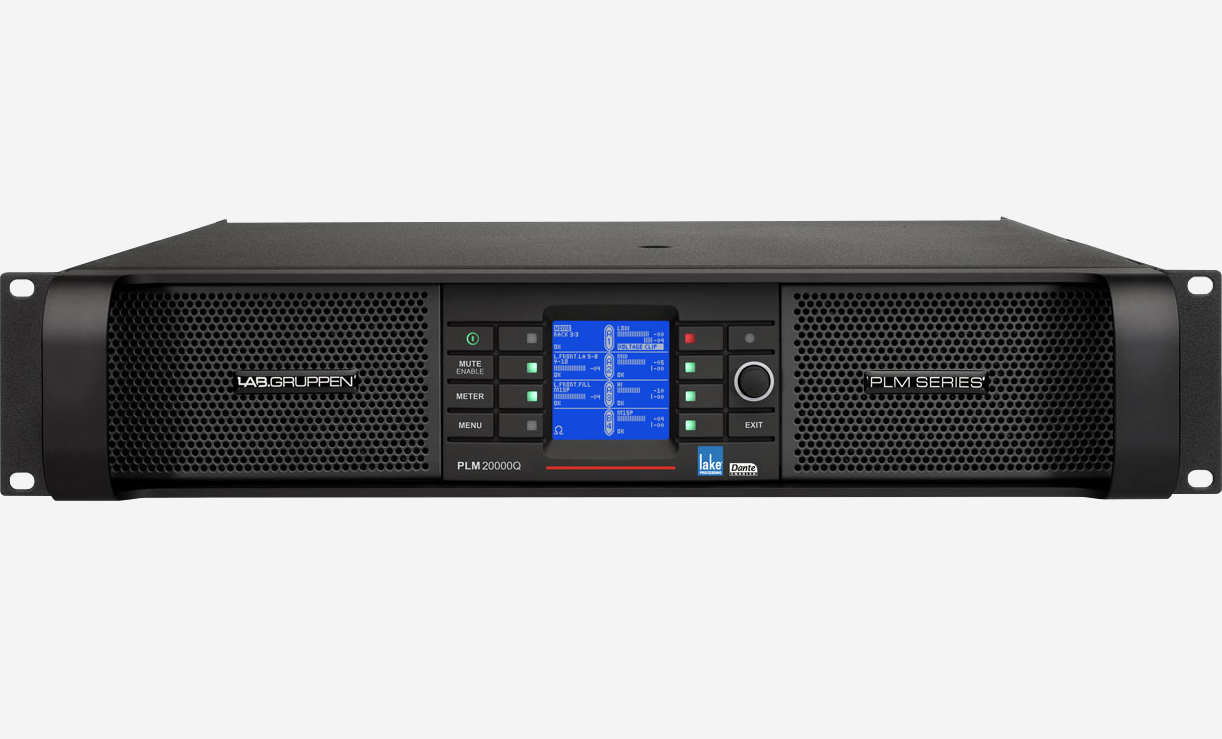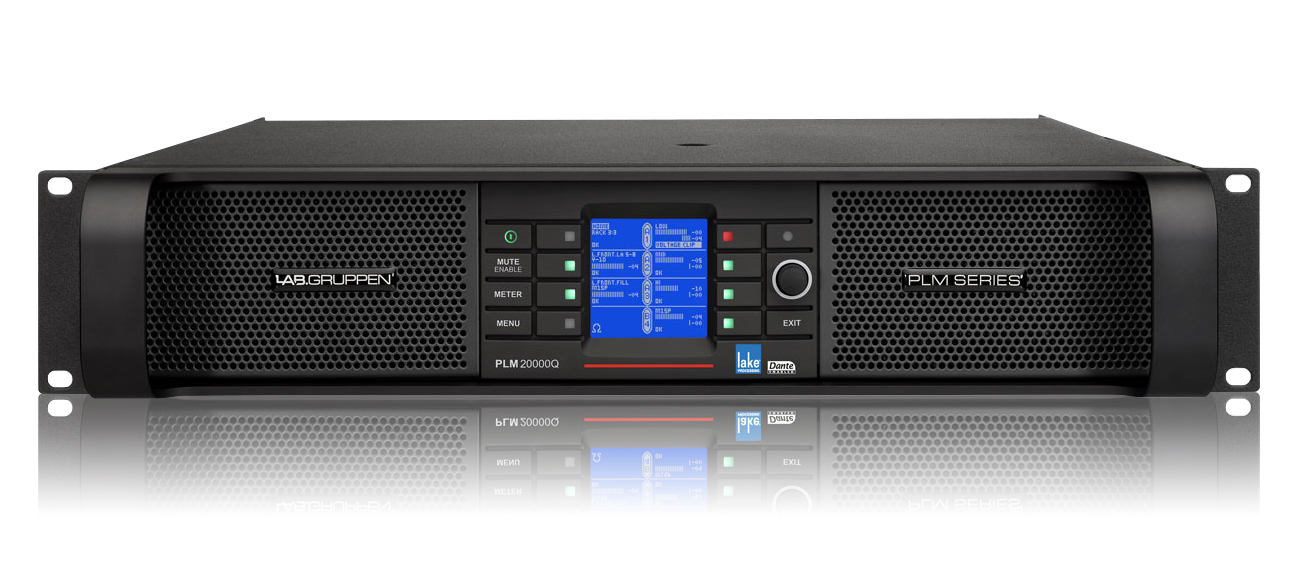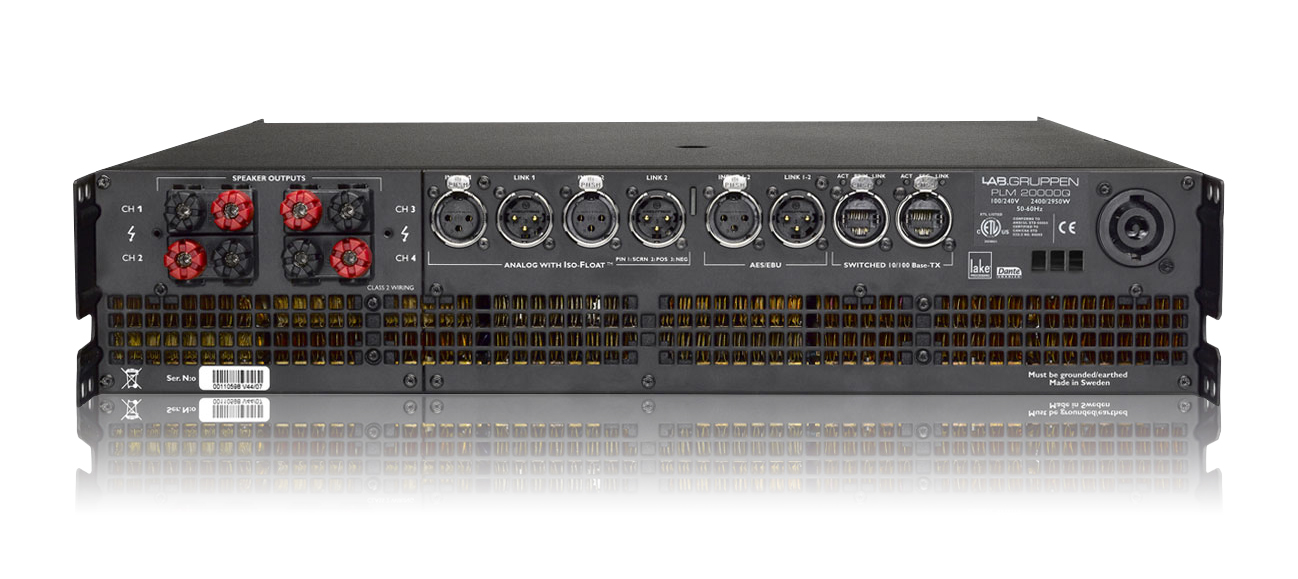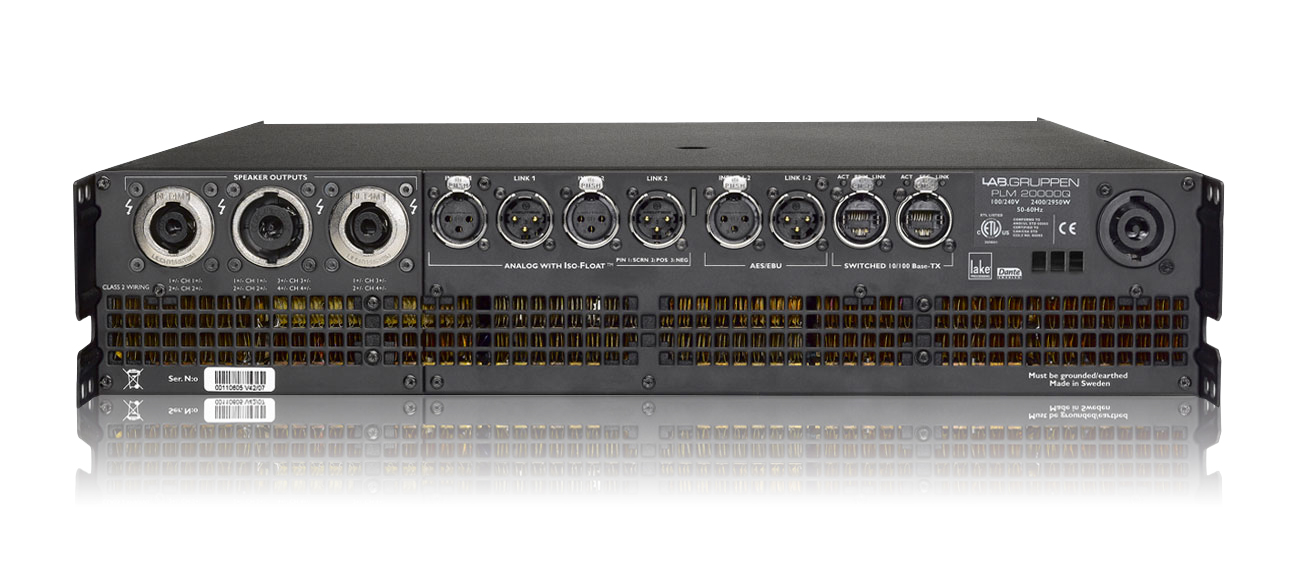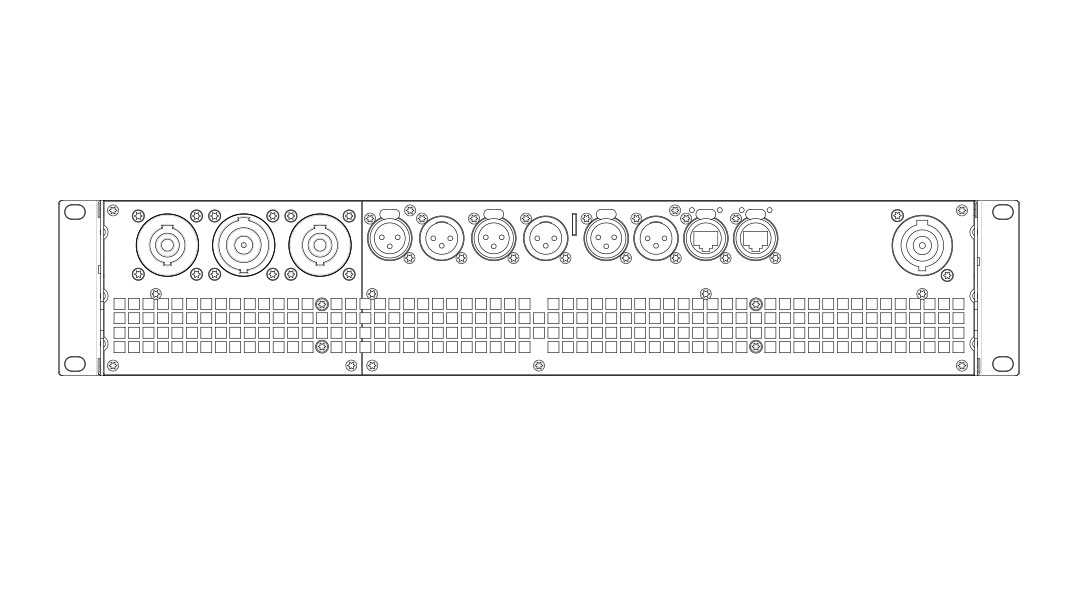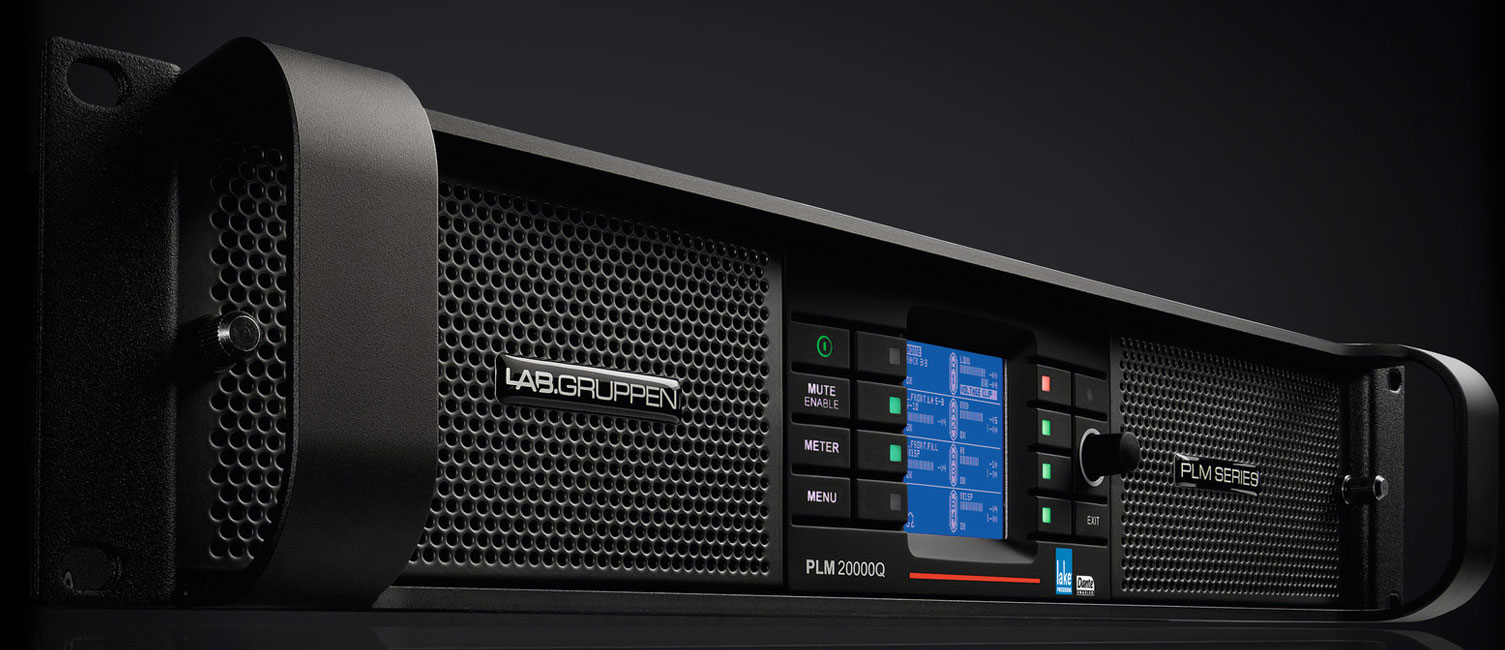PLM 20000Q
The power amplifier platform of the PLM 20000Q integrates several new developments to maintain reliable, sustained output at unprecedented power levels. The Regulated Switch Mode Power Supply (R.SMPS) is a new universal design that connects to any mains supply in the world. (Operating range is 100 V - 265 V, but new Under Voltage Limiting extends operation down to 65 V with reduced output power.) The design also incorporates power factor correction (PFC) to reduce peak current draw from the mains.
Load Verification and Continuous Performance Monitoring The PLM 20000Q includes a revolutionary set of tools for accurate load verification and real-time performance monitoring. The key to both features is LoadLibrary, a comprehensive database that provides unique “Fingerprints” (load characteristics) for each loudspeaker model in the system.
Lake Processing The PLM 20000Q contains two Lake Processing modules, each offering precise settings for gain, delay, crossover slope, equalization, and limiting. Exclusive Lake Processing algorithms are included for Raised Cosine Equalization, linear phase crossovers, LimiterMax loudspeaker protection, and Iso-Float ground isolation. Raised Cosine Equalization is the foundation for the Lake Mesa EQ and the Ideal Graphic EQ. Mesa EQ offers asymmetric filtering to match the asymmetric responses of many loudspeaker systems; the Ideal Graphic EQ offers true sum-to-flat response, so the adjustments provide uniform boost and cut along with greater selectivity. Lake Controller Software Lake Controller software provides a unified interface for control and monitoring of all functions of the PLM 20000Q. In addition to controlling all parameters of standard Lake Processing, new versions also provide control and monitoring of exclusive PLM features: digital input gain and attenuation, and load verification and performance monitoring via LoadSmart and SpeakerSafe. The Lake Controller software is optimized for a wireless Tablet PC. The same Lake Controller interface can be used to operate Dolby Lake Processors, Lake Contour, and Lake Mesa Quad EQ processors as part of a unified system.
Dante Digital Audio Network PLM Series Powered Loudspeaker Management systems are equipped with Dante, a self-configuring digital audio networking solution based on the newest developments in networking technology, Dante provides reliable, sample accurate audio distribution over Ethernet with extremely low latency. Dante incorporates Zen™, an automatic device discovery and system configuration protocol which enables PLM Series products and other Dante-enabled products to find each other on the network and configure themselves.
TECHNICAL SPECIFICATIONS
General Number of input channels: 2 Number of output channels: 4 Peak total output all channels driven: 20000 W Peak output voltage per channel: 194 V Max output current per channel: 67 A peak
Max output power all channels driven 16 ohms: 1150 W 8 ohms: 2300 W 4 ohms: 4400 W (*1) 2 ohms: 4800 W (*1) All channels driven into optimal impedance interval: > 5000 W into 2.2 - 3.3 ohms
Max output power bridged 8 ohms: 8800 W 4 ohms: 9600 W Bridged into optimal impedance interval: > 10000 W into 4.4 – 6.6 ohms
Performance THD + N 20 Hz - 20 kHz for 1 W: < 0.05 % THD + N at 1 kHz and 1 dB below clipping: < 0.04 % Dynamic range with digital inputs (for all supported sample rates): >114 dB Dynamic range with analog inputs: >110 dB Frequency response (1 W into 8 Ohm, 20 Hz - 20kHz): +/- 0.05 dB Common Mode Rejection (CMR): >74 dB, 20 Hz to 20 kHz Internal Sample Rate / Data path: 96 kHz / 32 bit floating point Product propagation delay (straight path analog server input -> amp): 1.61 ms Product propagation delay AES 96 kHz / analog input: 1.68 ms
Sample Rate Converters THD + Noise: 0.00003 %, 20 Hz - 20 kHz, unweighted
Analog to Digital inputs Inputs: 2 inputs x 2 link Input sensitivity settings: +12 or +26 dBu THD + Noise: 0.00022 %, typical at 1 kHz unweighted at +26 dBu headroom setting THD + Noise: 0.00033 %, typical at 20 Hz and 20 kHz unweighted at +26 dBu headroom setting
Gain, Sensitivity and Limiters Adjustable Inter-Sample Voltage Peak Limiter (ISVPL): 17.8 - 194 V, step size 0.1 V Current Peak Limiter < 300 ms: 67 A peak Current Average Limiter (CAL) > 300 ms: 33 Arms MaxRMS (rms voltage limiter): Yes MaxPeak (peak voltage limiter): Yes Output attenuator: -Inf to 0 dB, step size 0.25 dB
AES3/EBU (sample rate converters available as desired) Support redundant paths: Yes Flexible topology: Yes Supported sample rates: 48, 96 kHz
Back panel Interface AES / EBU / I/O (input + link): 2 x 3-pin XLR Analog, 2-channel I/O (input + link): 4 x 3-pin XLR, electronically balanced Output connectors: Neutrik speakON (1 x NLT8, 2 x NLT4) or 4 Binding Posts (pairs) Auto 10/100, Auto Uplink: 2 x RJ45 etherCON Control and monitoring interface: Via Ethernet for Lake Controller software, or DLM (the 3rd party protocol) Detachable mains cord: Neutrik PowerCon rated at 250V/32A Cooling: Three fans, front-rear airflow, temperature controlled speed
Device presets Local memory locations for the settings of the product: 100
Front-panel user interface Display: 2.5 inch, daylight readable LCD Fault/Warning/Limit/Clip indicators: RGB LEDs and detailed fault description on display Mute and soft function buttons: 8 provided Standby Power button: On/Standby Meter button: Toggles through meter views Menu: Provides a menu driven interface for full function front panel control Rotary Encoder: Yes Exit Button: Provides a “back” function
Power Operating voltage: 70-265 V AC Soft start / Inrush power: Yes/ Max 8 A Power Average Limiter (PAL): Yes Power Factor Correction (PFC): Yes Breaker Emulation Limiter (BEL): Yes, selectable breaker profile Under Voltage Limiter (UVL): Yes
Dimensions - Weight - Finish Rack rail to rear panel: W: 483 mm (19"), H: 88 mm (2 U), D: 424 mm (16") Weight: 17 kg (37 lbs) Finish: Black painted steel chassis with black painted steel / aluminum front
Approvals Approvals CE, ANSI/UL 60065 (ETL), CSA C22.2 NO. 60065, FCC
Notes *1: Asymmetrical loading of the outputs will yield even higher ratings. If one (or two) channel(s) has reduced power requirements, then the voltage drop from the power supply will be reduced, resulting in higher power availability for the other channel(s).
